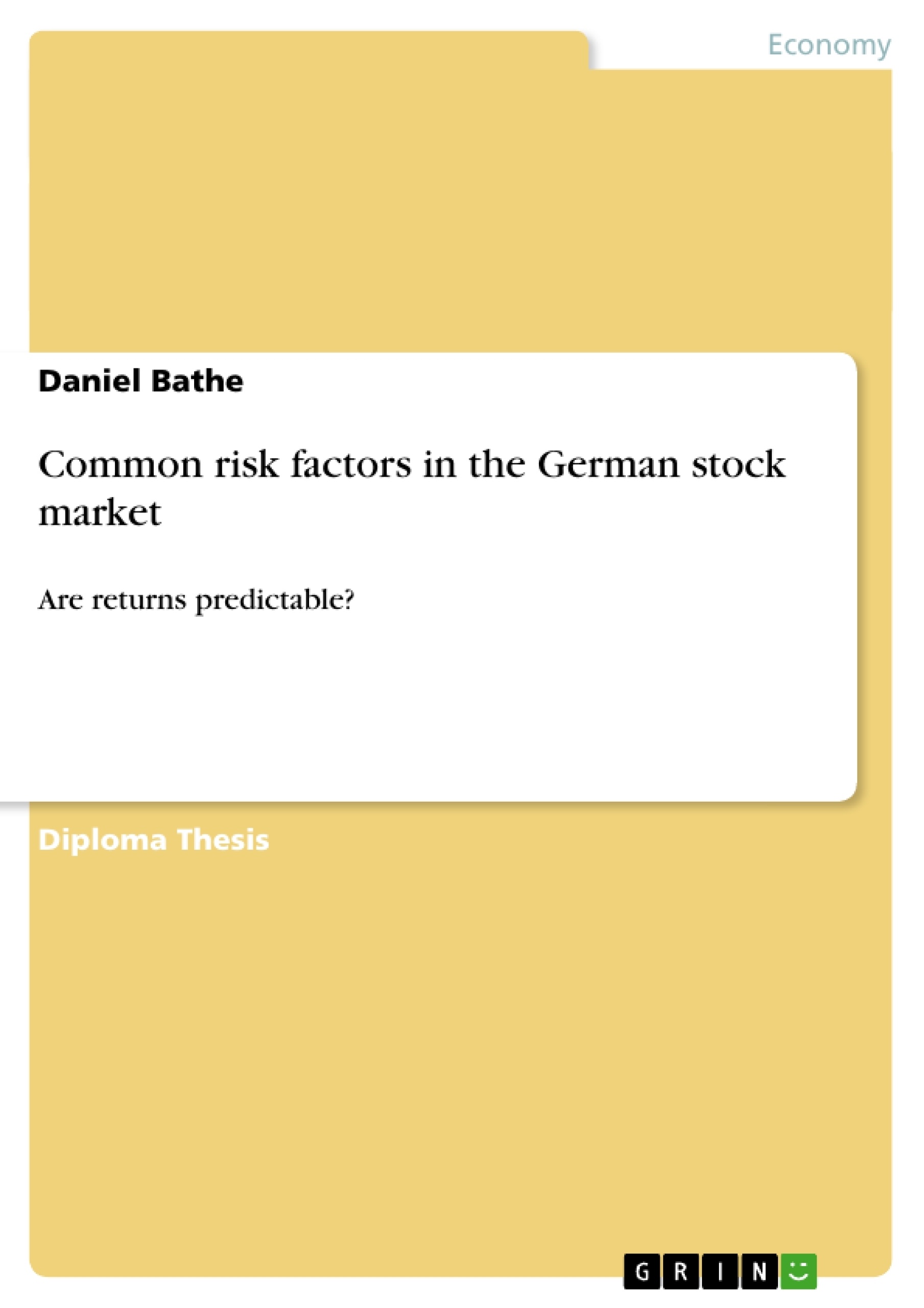This paper develops a multifactor model for explaining the difference in average returns for the German stock market in the period between July 1990 and June 2007. The methodology of Fama and French (1993) is adopted to determine possible common risk factors in that market. Despite the enormous and strong stock markets movements and the high volatility during that period, the three factors RM-RF, SMB and HML seem to be able to capture cross-sectional variation in average returns for portfolios formed on various sorting criteria based on publicly available financial data.
In addition, the analysis shows a negative (risk?) premium for small size stocks, which is a surprising result since it contradicts previous studies for the German, but also international markets. For stocks with a high book-to-market value, a strong positive premium is found. This value effect is consistent over time and statistically significant.
Positive premiums seem to exist for high E/P and C/P stocks as well. These market anomalies show that returns are indeed predictable in the German market over long time horizons. High BM, E/P and C/P stocks do outperform stocks with low ratios in these categories significantly and consistent over time.
However, the evidence in this analysis highlights that the common explanation in rational asset-pricing models of an outperformance due to some economic risk factors that are proxied by HML and SMB must be strongly questioned. Portfolios consisting of value stocks outperform growth portfolios in all possible states of the stock market. This evidence is contradictory to the ‘marginal value of wealth’ assumption in the rational asset pricing models presented. Additionally, there is a January effect in stock returns which cannot be captured by a risk-based, rational asset pricing model.
Thus, the evidence suggests that it is in fact investor irrationality which is causing differences in average returns across stocks. RM-RF, SMB and HML can be described as common factors helping to explain return differences, but it is very likely that it is not underlying economic risk, but investor behavior which is causing the presented market anomalies and return predictability.
Inhaltsverzeichnis (Table of Contents)
- 1 Introduction
- 2 The Efficient Market Hypothesis
- 2.1 The Efficient Market Theory and Asset Pricing Models
- 2.2 The Joint Hypothesis Problem
- 2.3 Asset Pricing Models - Literature Review
- 2.4 Arbitrage Pricing Theory
- 2.5 The Intertemporal CAPM
- 2.6 Finding the Factors
- 2.7 The Fama and French Three-Factor Model
- 3 Behavioral Explanations of Market Anomalies
- 3.1 The Limits to Arbitrage
- 3.2 Investor's Psychology
- 3.3 Empirical Evidence on Behavioral Phenomena
- 3.4 Behavioral Models
- 4 Empirics - The Fama-French Three-Factor Model for the German Market
- 4.1 Purpose of the Empirical Study
- 4.2 Testing Approach
- 4.3 Data and Methodology
- 4.4 The 16 Dependent Portfolios
- 4.5 The Common Risk Factors: RM-RF, SMB and HML
- 4.6 Results for the Time Series Regression
- 4.7 Analysis of the Alpha Constant
- 4.8 Testing for E/P and C/P
- 4.9 Risk in Value Strategies
- 4.10 Testing for Seasonality in Returns
- 5 Risk or Irrationality?
- 5.1 Rational Interpretations of the Three-Factor Model
- 5.2 Behavioral Interpretations of the Three-Factor Model
- 6 Conclusion
Zielsetzung und Themenschwerpunkte (Objectives and Key Themes)
This paper explores the predictability of returns in the German stock market, examining the role of common risk factors and behavioral explanations for observed market anomalies. The study analyzes the Fama-French three-factor model within the context of the German market, employing empirical analysis to investigate the relationship between risk factors and portfolio returns.
- Efficient Market Hypothesis (EMH) and its limitations
- Asset pricing models, including Arbitrage Pricing Theory (APT) and the Intertemporal CAPM (ICAPM)
- Behavioral finance and its role in explaining market anomalies
- The Fama-French three-factor model and its application to the German market
- The impact of risk factors on portfolio returns and the potential for generating alpha
Zusammenfassung der Kapitel (Chapter Summaries)
- Chapter 1: Introduction - Introduces the research question and outlines the structure of the paper.
- Chapter 2: The Efficient Market Hypothesis - Discusses the EMH and its implications for asset pricing models. Explores different models, including APT and ICAPM, and examines the joint hypothesis problem.
- Chapter 3: Behavioral Explanations of Market Anomalies - Examines the limitations of the EMH and explores behavioral explanations for market anomalies. Discusses the limits to arbitrage, investor psychology, and empirical evidence on behavioral phenomena.
- Chapter 4: Empirics - The Fama-French Three-Factor Model for the German Market - Details the empirical study, outlining the methodology, data used, and the analysis of the Fama-French three-factor model for the German market.
- Chapter 5: Risk or Irrationality? - Explores both rational and behavioral interpretations of the findings from the three-factor model analysis.
Schlüsselwörter (Keywords)
Efficient Market Hypothesis, asset pricing models, Arbitrage Pricing Theory, Intertemporal CAPM, behavioral finance, market anomalies, Fama-French three-factor model, risk factors, portfolio returns, alpha, German stock market.
- Citation du texte
- Daniel Bathe (Auteur), 2007, Common risk factors in the German stock market , Munich, GRIN Verlag, https://www.grin.com/document/90208



